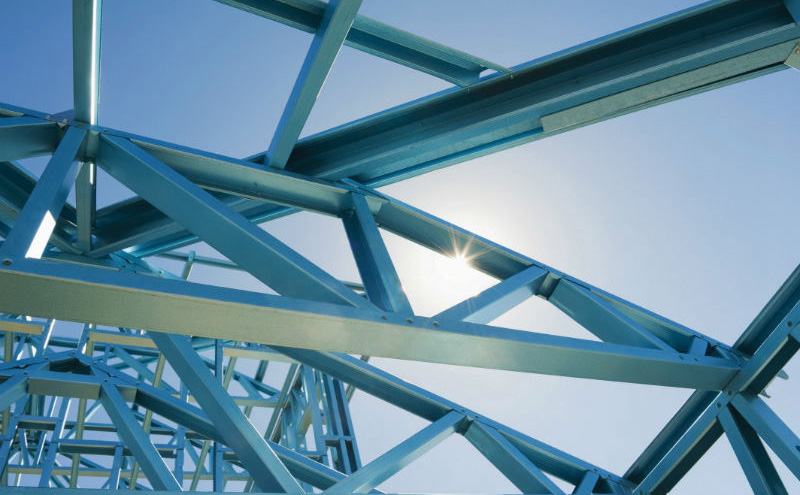
THE £35m project nearing completion has made full use of structural steelwork’s advantages in a development that has seen main contractor Morrison Construction provide a new school and arts centre, a halls of residence, and a swimming pool and squash courts – all in Kirkwall – and a primary school in Stromness that became operational in January.
Kirkwall is a centre of education and a focus for the local arts scene, both of which will be accommodated within the new Kirkwall Grammar School (KGS), the largest component of the programme.
Under construction on the existing school’s site, on land previously occupied by playing fields, the new school has been designed to create a distinctive focal point for pupils and the community. To that end the school structure includes the 350-seat Orkney Arts Theatre within its overall footprint. It has been designed as a public performance venue as well as a facility for pupils to use during school hours.
The project comprises one large building consisting of three teaching wings connected by an interlinking curved ‘street’ – that also accommodates social and dining spaces – with the oval-shaped Arts Theatre located at the head.
Providing 15,000m2 of floor space, the building is one of the biggest structures in Kirkwall. It has a curving and irregular shape and so movement joints have been placed at strategic points to break up the mass. Designed as a pin-jointed steel frame, cross bracing, located in partition walls, cores and risers, provides all of the structural stability.
“Much of the steelwork is quite complex with a lot of curved members in the theatre,” explains Ronnie Bruce, Morrison’s project director. “However, even though we’ve experienced some extreme conditions, especially the windy weather, the steel erection remained on target and was completed on schedule.”
As well as the relative ease and speed of construction, a number of other factors were in steelwork’s favour when it came to the decision to choose the framing material for KGS.
“We reviewed all materials but went with steel as deliveries would be easier and construction would be quicker. The steelwork is prefabricated and just has to be lifted and bolted into place, while the use of cellform beams has allowed us to keep the weight of the frame down which in turn kept costs down,” adds Bruce.
“Initially the project’s cores were to be concrete, but we changed these to steel framed as it was cheaper and allowed us somewhere to place bracing.”
Steelwork contractor BHC started on site towards the end of 2011 and by arranging the job into six phases, it was able to work its way down the structure in a sequential manner, allowing follow-on trades to get started on areas where the steelwork had been completed and the metal decking and precast stairs installed.
Each phase contains a core and plenty of cross bracing, which meant that as each area was erected it was immediately self- supporting and stable. This was useful considering the windy conditions the frame had to endure and was another reason why steel proved to be the right choice. Shuttering to form an irregular-shaped concrete structure would have been more expensive and may not have fared so well in the Orkney conditions.
“The entire shape of the school presented a challenge as the grid changes regularly, but the final sector – the theatre – was the most complex requiring a thousand individual steel pieces,” explains Eddie Brown BHC’s project manager.
The oval shape of the theatre required a number of curved beams to be supplied to the project. These members not only form the curved perimeter of the venue, but were used to construct two storeys of classrooms that wrap around a portion of the theatre.
The complexity of the steel frame is at its greatest where the theatre joins the main school building. Here, a large entrance foyer, which connects into the main central atrium, has curved members adjoining a straighter line of steel columns and beams.
Forming the open plan, column-free space of the theatre are two 17-metre long trusses, positioned on either side of what will become the main stage. These large steel sections were brought to site fully assembled and erected during one weekend after getting a police escort through Kirkwall’s narrow streets from the ferry terminal.
All the project’s materials have to be transported from the mainland (the steel arrived by ship from Aberdeen) and BHC had to limit each load to 25 tonnes, with the longest individual load at 24 metres long.
Aiming for a BREEAM ‘Excellent’ rating, the KGS school is scheduled to be operational later this year. That will allow the ‘old’ school buildings to be demolished and clear the space for new playing fields.
Image – The project comprises one large building consisting of three teaching wings connected by an interlinking curved ‘street’ with the oval-shaped Arts Theatre at the head. At 15,000m2 of floor space, the building is one of the biggest structures in Kirkwall.








